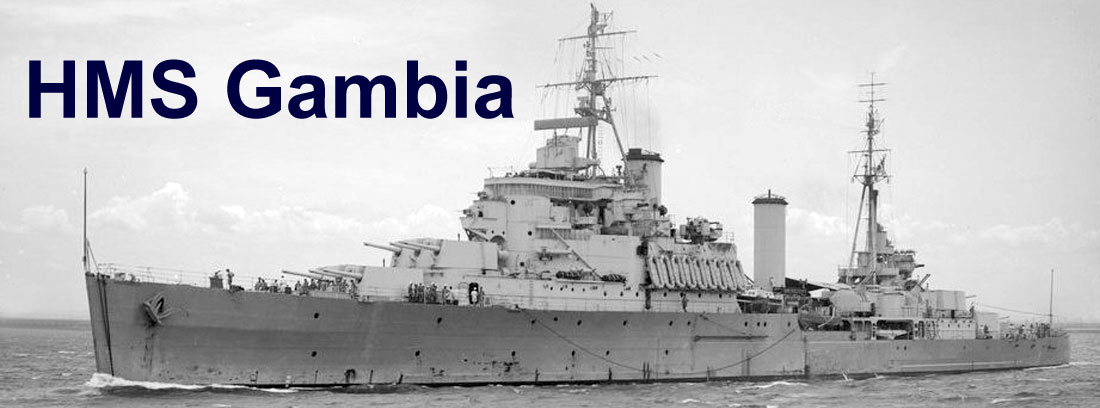
Jack Stanley Harker
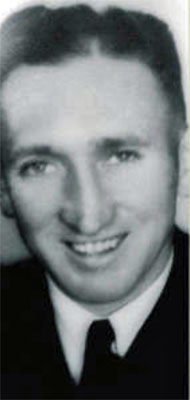 Jack was born on August 27, 1916.
Jack was born on August 27, 1916.
Jack had a long navy career, enlisting in 1933 and leaving in 1946 as Cheif Petty Officer with the number RNZN 1210. He served on HMNZS Philomel, Dunedin, HMS Diomede, HMS Achilles, Wakakura, HMNZS Leander, HMCS Tadoussac (1944), Gibraltor Naval W/T Station, HMNZS Gambia (1954), and HMNZS Tamaki. He was a PettyOfficer and his service number was RNZN 1210.
He was awarded the Queen's Service Medal (QSM) in 2002, and passed away on February 8, 2008, aged 91.
Jack had written about the Royal New Zealand Navy for many years and his books include Well Done, Leander (1971), HMNZS Achilles (1980), Almost HMNZS Neptune (1991), Soldier, Sailor, Priest: Biography of the Reverend George Trevor Robson (1992), The Rockies: New Zealand Minesweepers At War (2000), The Birth and Growth of the Royal New Zealand Navy (2001), All at Sea (2004), Wayfarer & Warrior: The Monowai Story (2005), Left Hand Down a Bit! The Wakakura Story (2006), and, of course, HMNZS Gambia in 1989.
Royal New Zealand Navy's Last Morse Message
In 1999, when Jack was 83, the Royal New Zealand Navy received its last morse code message - and Jack was there to see it being sent by 20 year old able radio officer Fiona Hay at Devonport. The following comes from the RNZN Communicators Association website.
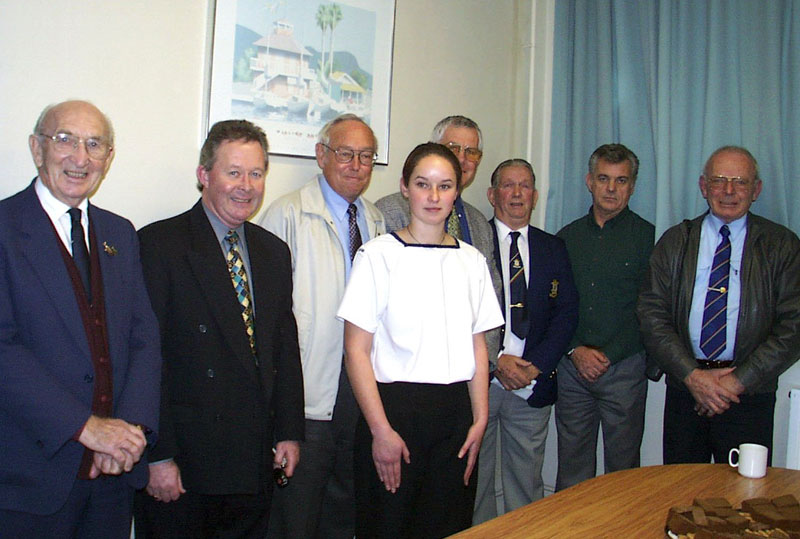
Jack Harker, on the left, at the Royal New Zealand Navy's last morse transmission
Jack Harker, 83, recalled how an attack by the New Zealand minesweepers Moa and Kiwi on a Japanese submarine allowed American divers to capture a new enemy Morse code to devastating effect. The submarine sank off the Solomon Islands with thousands of copies of the code, which the divers found in a clandestine mission. That let the Americans decipher travel plans of Japanese naval commander and mastermind of the attack on Pearl Harbour Admiral Isoroku Takano Yamamoto, whom they killed in an air ambush over Bougainville.
Mr. Harker saw action on the three New Zealand cruisers Leander, Achilles and Gambia but his most spine-tingling moment was receiving a Morse signal about the German pocket battleship Admiral Scheer. He was on the Leander in the Indian Ocean in 1940 when the Australian cruiser Canberra reporting spotting the sister-ship to the Graf Spee, which the Achilles had helped sink the year before. "They reported a position so close to ours that it almost made the hair stand up on my neck because we knew what a pocket battleship could do to a cruiser" But orders to shadow the enemy until nightfall before attacking it were countermanded when the Canberra sent another signal confessing that what it thought was the battleship was in fact the Leander. The two allied ships later sank the Admiral Scheer's supply ship and tanker but were unable to catch the main prize.
New Zealand's Jack Harker, sailor and author, receiving the Queen's Service Medal in 2002
Bill Hartland the author of the original HMS Gambia website had the pleasure of meeting Jack when Bill visited Jack at his home in Birkenhead, Auckland, New Zealand on April 3, 2006.

Bill Hartland with Jack Harker on April 3, 2006. Jack was the author of the book "HMNZS Gambia" which was published in 1989. Photo kindly supplied by Bill Hartland.

Jack Harker having lunch at the RSA Club, Browns Bay, Auckland during Bill's visit.
The following clipping came from the North Harbour News of Friday, September 1, 2006 and was written by Ben Watson:
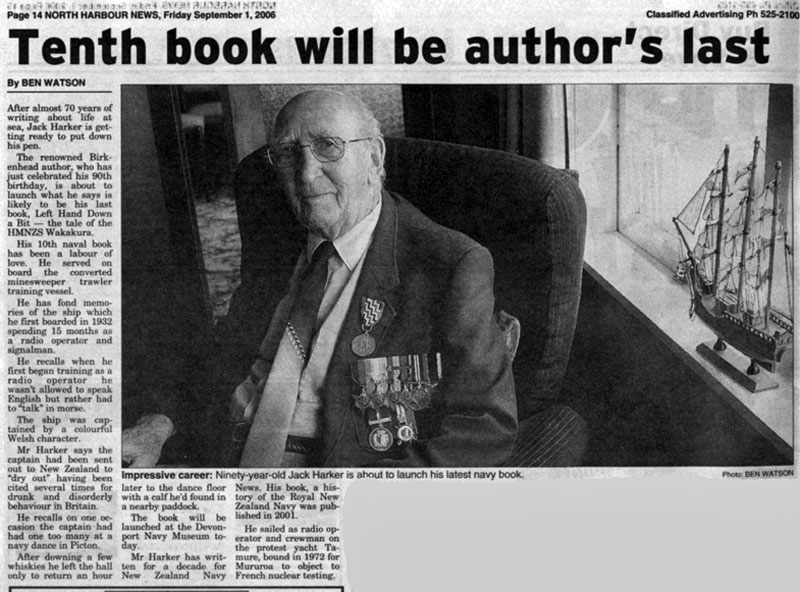
The text is:
Tenth Book will be Author's Last by Ben Watson
After 70 years of writing about life at sea, Jack Harker is getting ready to put down his pen. The renowned Birkenhead author, who has just celebrated his 90th birthday, is about to launch what he says is likely to be his last book, Left Hand Down a Bit — the tale of the HMNZS Wakakura.
His 10th naval book has been a labour of love. He served on board the converted minesweeper trawler training vessel. He has fond memories of the ship which he first boarded in 1932 spending 15 months as a radio operator and signalman.
He recalls when he first began training as a radio operator he wasn't allowed to speak English but rather had to "talk" in morse.
The ship was captained by a colorful Welsh character.
Mr. Harker says the captain had been sent out to New Zealand to "dry out" having been cited several times for drunk and disorderly behavior in Britain.
He recalls on one occasion the captain had had one too many at a navy dance in Picton.
After downing a few whiskies he left the hall only to return an hour later to the dance floor with a calf he'd found in a nearby paddock.
The book will be launched at the Devonport Navy Museum today.
Mr. Harker has written for a decade for New Zealand Navy News. His book, a history of the Royal New Zealand Navy was published in 2001.
He sailed as radio operator and crewman on the protest yacht Tamure, bound in 1972 for Mururoa to object to French nuclear testing.
The Weekend Press of February 23, 2008, had this to say on Jack's passing:
Man of the Sea and Last to be Flogged
Jack Harker was a teller of tales. His fellow sailors loved him because he told their stories— truthfully, without sentiment or censorship. He wrote many books and articles on the sea, which Chief of Navy RearAdmiral David Ledson says "read like one long letter home". His stories were told from the point of view of the men who served below decks.
The Christchurch-born sailor, who was raised at Governors Bay, died recently in Auckland. A stroke and broken hip from a fall last year led to his death from post-operative heart failure. He was 91.
Harker was the son of a Royal Navy rating from Liverpool, who served exclusively "before the mast" (on sailing vessels). Love of the sea came from his father. Harker's daughter, Gael Thompson, says the sea was his lifelong passion.
Harker's mother died in the 1918 influenza epidemic in Christchurch, and he was brought up at Cholmondeley Home from the age of two. He attended Christchurch Technical College and joined the NZ Division of the Royal Navy in 1932 as a wireless operator. He served in a range of ships and shore stations, including mine sweepers and the famous NZ cruisers Leander, Achilles and Gambia.
He saw active service in the Mediterranean and the Pacific in World War 2.
Harker rose to the rank of chief petty officer. However, his proudest achievement in the Navy was to be the last man to receive 12 lashes for a misdemeanour. He enjoyed telling how a doctor checked his heart before the flogging, his wrists were tied and he was draped over a hammock. His misdeed involved bringing a vessel into harbour without proper authority. This nearly caused him to be court-martialled— he seemed grateful to gain the distinction of a flogging instead.
His daughter says he was "a real character and something of a rebel", who never took a step back from anyone. He won a naval lightweight boxing title.
After leaving the Navy, Harker worked as a radio technician with Radio Station 3YA in Christchurch. He married Marguerite Cumming, of Christchurch, and they had five children. His wife died in 1996.
Later he worked in radio at Wellington but, finding money tight, took up dairy farming in Northland. He then worked in local government, until retiring in 1981.
Although working ashore, he still put to sea whenever possible. In 1972 he crewed as wireless operator on the Greenpeace yacht Tamure, with author Maurice Shadbolt, to protest at French nuclear tests in the Southern Pacific. His daughter says he was not a member of the peace movement but felt very strongly that the French actions were wrong— so strongly that he missed a daughter's wedding to join the protest.
Harker began serious writing in retirement. In addition to contributing articles to the NZ Navy News, he authored 10 books of New Zealand naval history. Most of these dealt with respective vessels but some were biographies and general histories. Among them was his autobiography, All at Sea. His writings had many humorous anecdotes and gave a "warts and all" picture of the Navy. He was awarded the Queen's Service Medal in 2002 for his recording of NZ naval history.
Jack Stanley Harker, QSM, born Christchurch, August 27, 1916; died Auckland, February 8, 2008. Predeceased by wife Marguerite and daughter Sheryn; survived by daughters Gael and Jan, sons Malcolm and Philip and his grandchildren.
The following clipping came from the Weekend Herald of Saturday, March 1, 2008 and was written by Arnold Pickmore:
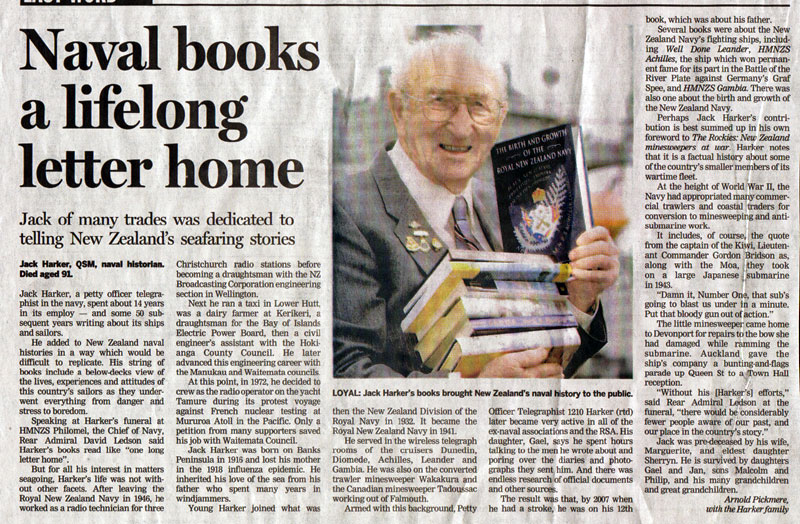
The text is:
Naval books a lifelong letter home
Jack of many trades was dedicated to telling New Zealand's seafaring stories
Jack Harker, QSM, naval historian. Died aged 91.
Jack Harker, a petty office telegraphist in the navy, spent 14 years in its employ – and some 50 subsequent years writing about its ships and sailors.
He added to New Zealand naval histories in a way which would be difficult to replicate. His string of books include a below-decks view of the lives, experiences and attitudes of this country's sailors as they underwent everything from danger and stress to boredom.
Speaking at Harker's funeral at HMNZS Philomel, the Chief of Navy, Rear Admiral David Ledson said Harker's books read like "one long letter home".
But for all his interest in seagoing, Harker's life was not without other faces. After leaving the Royal New Zealand Navy in 1946, he worked as a radio technician for three Christchurch radio stations before becoming a draughtsman with the NZ Broadcasting Corporation engineering section in Wellington.
Next he ran a taxi in Lower Hutt, was a dairy farmer at Kerikeri, a draughtsman for the Bay of Islands Electric Power Board, then a civil engineer's assistant with the Hokianga County Council. He later advanced this engineering career with the Manukau and Waitemata councils.
At this point, in 1972, he decided to crew as the radio operator on the yacht Tamure during its protest voyage against French nuclear testing at Mururoa Atoll in the Pacific. Only a petition from many supporters saved his job with Waitemata Council.
Jack Harker was born on Banks Peninsula in 1916 and lost his mother in the 1918 influenza epidemic. He inherited his love of the sea from his father who spent many years in windjammers.
Young Harker joined what was then the New Zealand Division of the Royal Navy in 1932. It became the Royal New Zealand Navy in 1941.
He served in the wireless telegraph rooms of the cruisers Dunedin, Diomede, Achilles, Leander and Gambia. He was also on the converted trawler minesweepr Wakakura and the Canadian minesweeper Tadoussac working out of Falmouth.
Armed with this background, Petty Officer Telegraphist 1210 Harker (rtd.) later became very active in all of the ex-naval associations and the RSA. His daughter, Gael, say he spent hours talking to the men he wrote about and poring over the diaries and photographs they sent him. And there was endless research of official documents and other sources.
The result was that by 2007 when he had a stroke, he was on his 12th book which was about his father.
Several books were about the New Zealand Navy's fighting ships, including Well Done, Leander, HMNZS Achilles, the ship which won permanent fame for its part in the Battle of the River Plate against Germany's Graf Spee, and HMNZS Gambia. There was also one about the birth and growth of the New Zealand Navy.
Perhaps Jack Harker's contribution is best summed up in his own foreword to The Rockies: New Zealand minesweepers at War, Harker notes that it is a factual history about some of the country's smaller members of its wartime fleet.
At the height of World War II, the Navy had appropriated many commercial trawlers and coastal traders for minesweeping and anti-submarine work.
It includes, of course, the quote from the captain of the Kiwi, Lieutenant Commander Gordon Bridson as, along with the Moa, they took on a large Japanese submarine in 1943.
"Damn it, Number One, that sub's going to blast us under in a minute. Put the bloody guns out of action".
The little minesweeper came home to Devonport for repairs to the bow he had damaged while ramming the submarine. Auckland gave the ship's company a bunting-and-flags parade up Queen St. to a Town Hall reception.
"Without his [Harker's] efforts," said Rear Admiral Ledson at the funeral, "there would be considerably fewer people aware of our past, and ourplace in the country's history."
Jack was predeceased by his wife, Marguerite, and eldest daughter Sherryn. E is survived bt daughters Gael and Jan, sons Malcolm abd Philip, and his many grandchildren and great grandchildren.
Arnold Pickmore
with the Harker family.
In January 2022, Jay Anaru sent this cliiping he found in the back of is father's copy of HMNZS Gambia by Jack Harker. Jay's father was Eric John Steele who served on Gambia as as Able Seaman, 1944/45. The clipping comes from The Bay of Plenty Times of April 7, 1990 and was written just after "HMNZS Gambia" was written and shorty before "Almost HMNZS Neptune" was published.
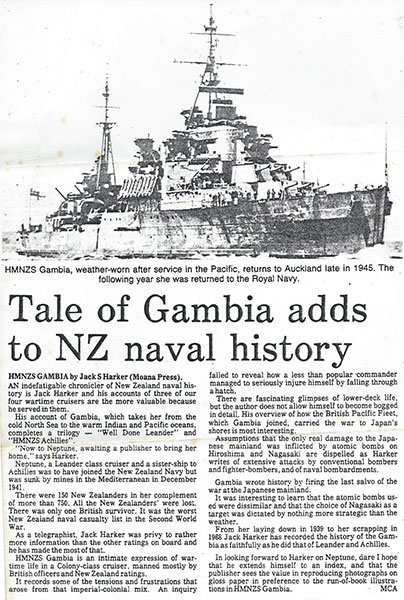
Tale of Gambia add to NZ Naval History
HMNZS GAMBIA by Jack S Harker (Moana Press).
AN indefatigable chronicler of New Zealand naval history is Jack Harker and his accounts of three of our four wartime cruisers are the more valuable because he served in them.
His account of Gambia, which takes her from the cold North Sea to the warm Indian and Pacific oceans, completes a trilogy - "Well Done Leander" and "HMNZS Achilles".
"Now to Neptune, awaiting a publisher to bring her home," says Harker.
Neptune, a Leander class cruiser and a sister-ship to Achilles was to have joined the New Zealand Navy but was sunk by mines in the Mediterranean in December 1941.
There were 150 New Zealanders in her complement of more than 750. All the New Zealanders' were lost. There was only one British survivor. It was the worst New Zealand naval casualty list in the Second World war.
As a telegraphist, Jack Harker was privy to rather more information than the other ratings on board and he has made the most of that.
HNNZS Gambia is an intimate expression of war-time life in a Colony-class cruiser, manned mostly by British officers and New Zealand ratings. It records some of the tensions and frustrations that arose from that imperial-colonial mix.
An inquiry failed to reveal how a less than popular commander managed to seriously injure himself by falling through a hatch.
There are fascinating glimpses of lower-deck life, but the author does not allow himself to become bogged in detail. His overview of how the British Pacific Fleet, which Gambia joined, carried the war to Japan's shores is most interesting.
Assumptions that the only real damage to the Japanese mainland was inflicted by atomic bombs on Hiroshima and Nagasaki are dispelled as Harker writes of extensive attacks by conventional bombers and fighter-bombers, and of naval bombardments.
Gambia wrote history by firing the last salvo of the war at the Japanese mainland.
It was interesting to learn that the atomic bombs used were dissimilar and that the choice of Nagasaki as a target was dictated by nothing more strategic than the weather.
From her laying down in 1939 to her scrapping in 1968 Jack Harker has recorded the history Of the Gambia as faithfully as he did that of Leander and Achilles.
In looking forward to Harker on Neptune, dare I hope that he extends himself to an index, and that the publisher sees the value in reproducing photographs on gloss paper in preference to the run-of-book illustrations in HMNZS Gambia.
MCA
Sources
Auckland Museum Online Cenotaph
RNZN Communicators Association - Over and Out – the final Morse transmission of the New Zealand Navy
The Press